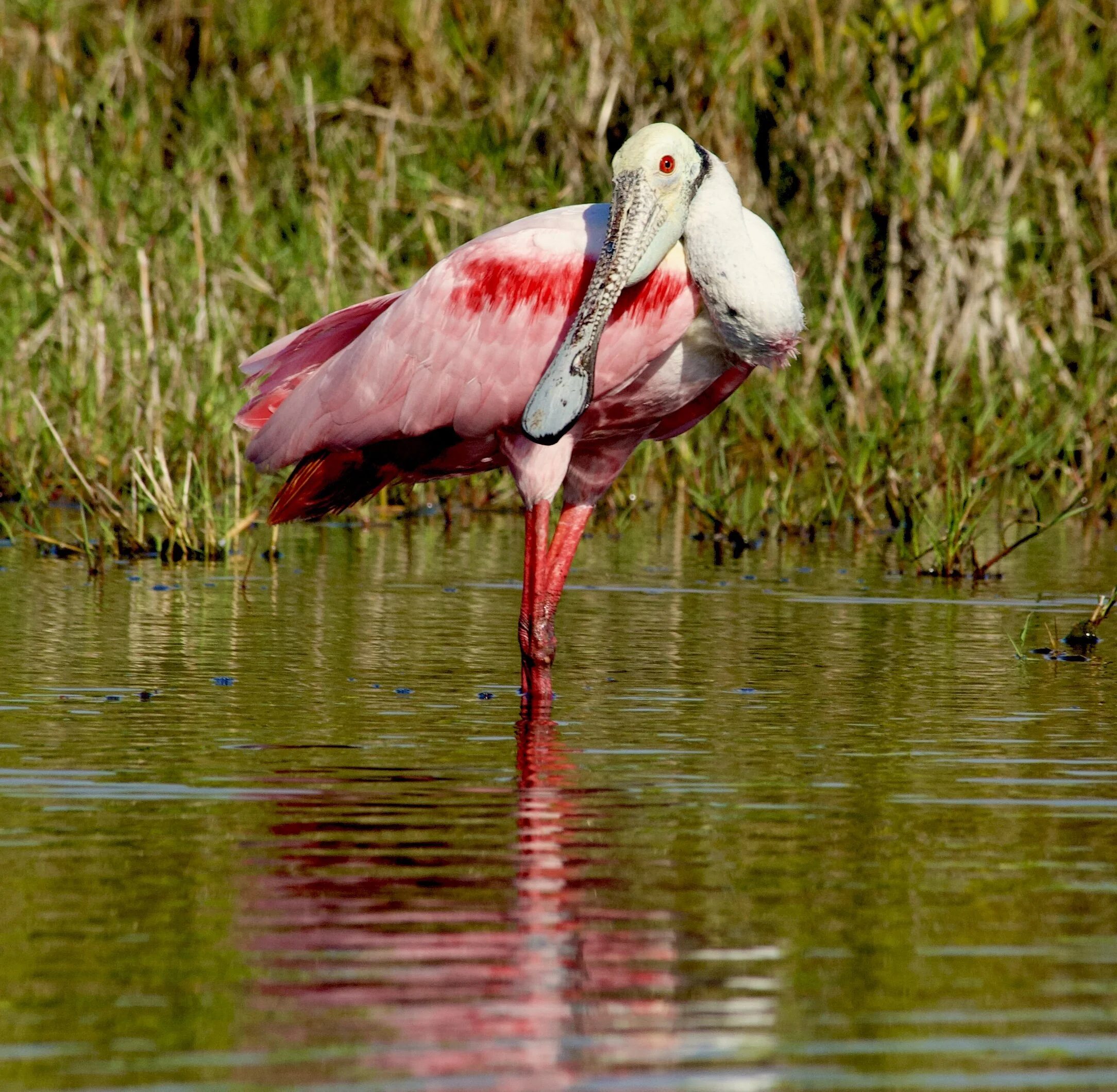Exploring Florida's Merritt Island National Wildlife Refuge
By: John Kumiski
A roseate spoonbill along the Black Point Wildlife Drive. Photo: John Kumiski
It might come as a shock to the average tourist, but the real Florida does not come equipped with roller coaster-like rides and mice on steroids. If you're in central Florida and you want to see the real deal, simply drive to Titusville and visit the Merritt Island National Wildlife Refuge (MINWR).
Ospreys use the fish resources of the lagoons to raise their families. Photo: John Kumiski
The MINWR, located on the north side of the Kennedy Space Center, encompasses 140,000 acres, over 200 square miles, of almost completely undeveloped wildlife habitat. You’ll find fresh and saltwater marshes, a large estuary, dunes, hardwood hammocks, and scrub habitats. Because of all the wildlife, the world's largest birding and wildlife festival is held in Titusville every January. Visit their website at https://scbwf.org for more information
You can explore the refuge by car, by boat, on foot, or use some combination of these. Let's take a look at the options for each.
By Car
There are two wildlife drives on the property, and both require a fee. The Black Point Wildlife Drive, seven miles long, snakes through a series of marshes. Visitors will see all kinds of birds, from tiny wrens to bald eagles. Alligators and otters are common sights, too. Two parking areas allow you to get out and walk some, if that's to your fancy. Bring binoculars and cameras! If you bird seriously, you probably already have a copy of Sibley's guide to birds. If you visit the refuge, you simply must visit this place!
A young alligator rests on a log. With some luck you'll see some much larger specimens at MINWR. Photo John Kumiski
BioLab Road runs along the west shore of Mosquito Lagoon, with the lagoon on one side and the marsh on the other. Lots of people fish in the lagoon from this road, species may include: redfish, seatrout, and black drum. Wildlife watching opportunities are similar to those at Black Point, although the chance of seeing bottle-nosed dolphins and alligators is much better here.
Also, a manatee viewing platform on the northeast side of the Haulover Canal allows visitors the opportunity to observe the gentle beasts, where they like to congregate during warmer days in the winter.
By Boat
When I say boat, I'm talking small vessels here, especially hand-powered ones. For folks with combustion, you'll find ramps at Haulover Canal, BioLab Road, and the Beacon 42 Fish Camp. The camp is long gone, but the ramp remains. The refuge charges a fee to use these ramps. Fishing for seatrout, redfish, and other species is very popular here.
Fishing for redfish is a popular and sometimes productive pastime for paddlers. Photo: John Kumiski
Paddlers have near-limitless options for launching. You can paddle on Mosquito Lagoon or the Indian River Lagoon to fish, bird-watch, or search for dolphins, manatees, or even reptiles! One very popular paddling option during the warmer months involves paddling after dark, especially on moonless nights, to observe the bioluminescence in the water. It's so cool to watch the mullet make bioluminescent tracks as they swim. Plus, you’ll get to see satellites and meteors at the same time!
If you don't have a boat, several outfitters run trips both night and day. If you do have a boat, a call or visit to the Visitor's Center will get you pointed in the right direction, depending on what you want to do.
On Foot
You'll find several hiking trails, with varying amounts of shade. Hiking is best when the weather is chilly! Biting insects make walking miserable when it warms up. I find ticks and chiggers particularly odious. Bring repellant! For walking in Florida, you need real walking shoes. Flip flops, sandals, and similar footwear are totally inadequate. You will also need plenty of water. Don't get dehydrated! A good hat and sunblock round out your outfit. Did I mention repellant?
The woods are sometimes dark and lovely along the Palm Hammock Trail. Photo John Kumiski
Having said that, you will find some lovely hikes here. I especially enjoy the Palm and Oak Hammock trails, a two-and-a-half mile walk combined. These are real trails. You'll encounter roots and mud. The woods here are dark and lovely in places and the vegetation exotic-looking, even for those who live in Florida. On my last hike here, I was crossing some water on the boardwalk when an otter swam almost right up to me. I don't know who was more surprised. Before I could reach the telephoto lens, he was long gone.
If you hope to see a scrub jay, try the one-mile long Scrub Ridge trail. Be prepared for direct sun. Few trees grow here. It's all flat, but easy walking. The Cruickshank Trail runs five miles on a dike around the marsh. Wading birds and waterfowl are the main attractions here. Again, not much shade, but flat, easy walking. If there aren't enough options here, call or visit to the Visitor's Center for more information.
A Gulf fritillary butterfly feeds on a blossom of Spanish needle. Photo: John Kumiski
This is just a quick roundup of how to explore the Merritt Island National Wildlife Refuge. If you find yourself in central Florida, you owe it to yourself to visit this truly magical place.
John Kumiski is a has been fishing, exploring, and enjoying the outdoor for 40 years. He was a longtime fishing guide in FL. He is the author of Fishing Florida by Paddle-An Angler’s Guide, which can be purchased HERE.
Have you done something interesting outdoors? Join Global Outdoors and write a review to tell everyone about it! We’re building the home for trusted reviews of outdoor experiences, outfitters, and guides. Help us out and you’ll be entered to win free trips!








